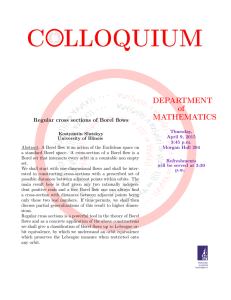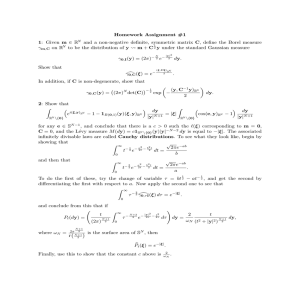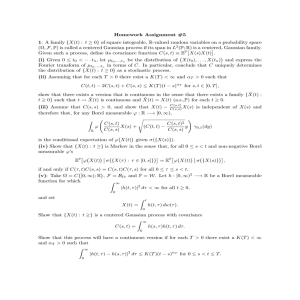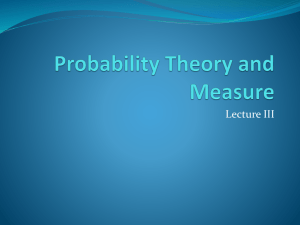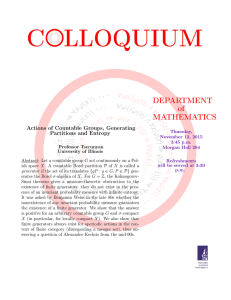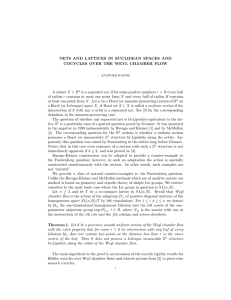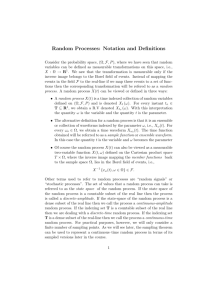From Borel’s remarks to subjective probability studies Journ@l Electronique d’Histoire des
advertisement
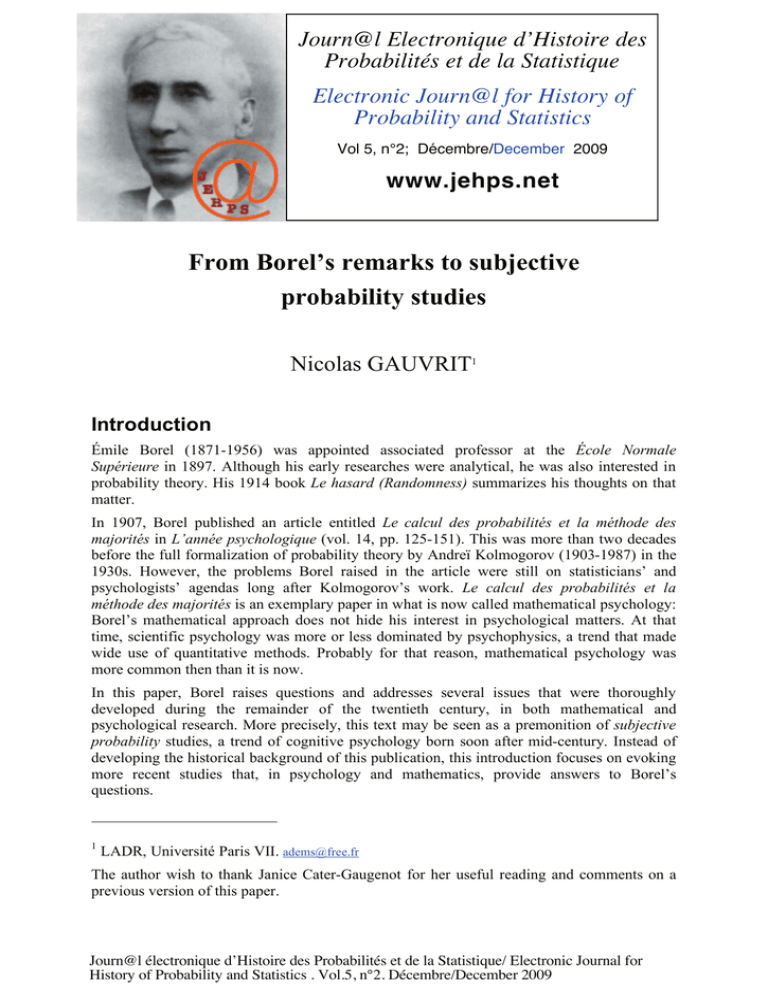
Journ@l Electronique d’Histoire des Probabilités et de la Statistique Electronic Journ@l for History of Probability and Statistics Vol 5, n°2; Décembre/December 2009 ������������� From Borel’s remarks to subjective probability studies Nicolas GAUVRIT1 ������������ Émile Borel (1871-1956) was appointed associated professor at the École Normale Supérieure in 1897. Although his early researches were analytical, he was also interested in probability theory. His 1914 book Le hasard (Randomness) summarizes his thoughts on that matter. In 1907, Borel published an article entitled Le calcul des probabilités et la méthode des majorités in L’année psychologique (vol. 14, pp. 125-151). This was more than two decades before the full formalization of probability theory by Andreï Kolmogorov (1903-1987) in the 1930s. However, the problems Borel raised in the article were still on statisticians’ and psychologists’ agendas long after Kolmogorov’s work. Le calcul des probabilités et la méthode des majorités is an exemplary paper in what is now called mathematical psychology: Borel’s mathematical approach does not hide his interest in psychological matters. At that time, scientific psychology was more or less dominated by psychophysics, a trend that made wide use of quantitative methods. Probably for that reason, mathematical psychology was more common then than it is now. In this paper, Borel raises questions and addresses several issues that were thoroughly developed during the remainder of the twentieth century, in both mathematical and psychological research. More precisely, this text may be seen as a premonition of subjective probability studies, a trend of cognitive psychology born soon after mid-century. Instead of developing the historical background of this publication, this introduction focuses on evoking more recent studies that, in psychology and mathematics, provide answers to Borel’s questions. 1 LADR, Université Paris VII. adems@free.fr The author wish to thank Janice Cater-Gaugenot for her useful reading and comments on a previous version of this paper. Journ@l électronique d’Histoire des Probabilités et de la Statistique/ Electronic Journal for History of Probability and Statistics . Vol.5, n°2. Décembre/December 2009 ������������������������ The paper starts by questioning the use of the at-that-time so-called méthodes des majorités, the idea that a majority opinion is to be considered valid, or at least more valid than a single or random opinion. At the very least, says Borel, one should inquire into possible applications and limits of this method. Throughout the text, examples are provided, mainly borrowed from psychophysics, psychometrics, and law. Section I lists a number of criticisms, specifically those made by Joseph Bertrand (1822-1900) against Nicolas de Condorcet (1743-1794), Pierre Simon Laplace (1749-1827), Siméon Denis Poisson (1781-1840) and Antoine-Augustin Cournot (1801-1877). They all, according to Bertrand, had been fooled by the beauty of probabilities and the méthode des majorités so much that they actually believed it might be relevant to legal decisions. Poisson, for instance, makes a distinction between guilty and “sentenceable” (condamnable), and argues that although the majority may be wrong in saying that someone is guilty, it may still be right in deciding he or she is sentenceable (i.e., he or she can rationally be declared guilty). This, argues Borel following Bertrand’s view, is a sophistic attempt to justify legal decisions in the context of a trial by using probabilities in an irrelevant manner. Nowadays, Poisson’s distinction would be understood as that between the truth and the rational conclusion. What Poisson suggests is that although a democratic process may not lead to the right choice, the majority decision is nonetheless rational. This assumption is flawed in two ways. The first, noticed by Borel, is that rationality simply is not of interest when it comes to justice. In a legal proceeding, we must seek truth and not rationality. An innocent who would rationally be convicted should be released. The second flaw that Borel does not mention directly in this section is the underlying assumption of rationality. Daniel Kahneman and Amos Tversky conducted several well-known studies on heuristics and biases that shed light on human irrationality. In a famous experiment [2, pp 153-160] for instance, they asked subjects to solve the following problem (the taxicab problem): A cab was involved in a hit-and-run accident at night. Two cabs companies, the Green and the Blue, operate at night. You are given the following data: (1) 85% of the cabs in the city are Green, and 15% are Blue. (2) A witness identifies the cab as a Blue cab. The court tested the witness' ability to identify cabs under the appropriate visibility conditions. When presented with a sample of cabs (half of which were Blue, half of which were Green), the witness made correct identifications in 80% of the cases and errors in 20% of the cases. Question: What is the probability that the cab involved in the accident was Blue rather than Green?” People usually answer that the probability is 80%, whereas the right answer is 41%. Their responses suggest they do not use the first fact (the “base rate”). This shows that people tend to ignore certain important pieces of information, so much so that they are likely to condemn an innocent person, based on facts that actually are meaningless, but that they feel are significant. It is important to notice that this type of error is more or less systematic, which means that if we actually use the méthode des majorités in such a case, a bigger jury is even more likely to be wrong. In section II, Borel makes an important distinction between what he calls absolute truth (vérité absolue) and relative truth (vérité relative). What he exactly means by relative truth is, however, difficult to capture. In section II, it is defined as the rational conclusion, whereas examples in the following sections show that it should sometimes be understood as the Journ@l électronique d’Histoire des Probabilités et de la Statistique/ Electronic Journal for History of Probability and Statistics . Vol.5, n°2. Décembre/December 2009 majority opinion or perception, regardless of its logical rationality. But the important point is that this relative truth, whatever it may be, has some objectivity. In some situations, says the author, the relative truth may be interesting in itself. In other situations our interest goes to absolute truth, which is unrelated, as far as we know, to relative truth. Sometimes, however, we are not even able to determine if there is even a relative truth. Section III treats the first situation, where the relative truth is interesting in itself, in mathematical terms. The example given is the case of studying language as people use it. If our purpose is to know what people spontaneously say, if an expression is used or not, and how it is generally understood, the méthode des majorités is the obvious solution. Borel then details certain practical difficulties one may encounter when trying to use that obvious solution. One century later, it all appears as classical results about inferential statistics and estimation: As we cannot in general discover what every person's opinion is, we must use inductive procedures based on the observation of a sample. That sample, ideally random, is not so in most real studies. It is therefore important, as Borel reminds us, to check that it is at least plausibly random or representative of the population. Moreover, our conclusion is not straightforward: a light majority could arise from mere chance. Calculations must be made using probability to ensure that we can with an acceptable probability generalize our sample observation to the population. Section IV deals with situations where the absolute truth is what we seek, even though it bears no relation that we know of to the relative truth. To illustrate this case, Borel brings up the example of a legal decision in which, he says, many psychological biases may impair our judgments. Another example is that of games of chance. It is well-established that a player should not expect to win any money, but should on the contrary be aware that he or she is likely to lose all her money. Unfortunately, says the author, players will not listen to mathematicians’ warnings; instead, they will cherish false hopes of good fortune and those who, like Charles Henry, suggest methods for winning more often than chance alone would allow. The section ends with an attack on Charles Henry's proposal to differentiate mathematical truth from psychological truth. According to Borel, this distinction has only one purpose: let the reader believe that there is a way to defeat chance. Many psychological studies of the late 20th century addressed this question in a scientific way. We may actually define a psychological truth in terms of heuristics and biases. Borel was right to notice that people share deep wrong convictions about what chance and probability are. These convictions are, precisely, the topic of subjective probability researches. It is amusing to notice that the title of Charles Henry’s book, The law of small numbers (La loi des petits nombres), is also that of a more recent article about subjective probability written by Tversky and Kahneman [7]. According to Borel’s account of the book, Henry tries to make the reader believe that we have access to clues about future drawings considering that chance will give a uniform distribution, even on a small number of drawings. This fallacy, consisting of using the law of large numbers (only valid as a limit) on a few drawings is precisely what Tversky and Kahneman called “the law of small numbers.” In their article they show that this “law” is a widely-held conception of randomness within the population, which partially explains players’ irrational behaviors. Section V introduces the two last sections dealing with the situation where we only have access to the relative truth, if any. Imagine that a majority has an opinion on a given topic. Can we take for granted that this opinion is the truth? The answer is, of course, no. If a majority opinion emerges, there is certainly a reason for that, but this reason may have nothing in common with truth itself. Borel borrows an example from psychophysics: if Journ@l électronique d’Histoire des Probabilités et de la Statistique/ Electronic Journal for History of Probability and Statistics . Vol.5, n°2. Décembre/December 2009 subjects are to decide which of two objects, A or B, is heavier, and if a majority vote for A, there might be different reasons for that. Of course, A may actually be the heavy object. Also, A and B might have similar weight, but different shapes. This important point should be kept in mind when reading the two last sections: a significant majority proves something, but may be not what we are looking for. A classical question in psychophysics deals with finding a link between a physical measure and its perception by humans. Section VI gives the illustration of perception of weight in relation to Weber’s law. Ernst Weber (1795-1878) is one of the founding fathers of psychophysics. To determine the link between the physical magnitude I of a stimulus (here the weight) and the corresponding perceived magnitude P, Weber measured the smallest difference of I that an average subject could notice. Let dI be this smallest difference. Weber and others noticed that dI/I was almost constant, from which they derived the formula dP = kdI/I, and thus P = klog(I) + c, now called Weber’s law. To determine dI, psychophysicians usually used forced choice experiments where subjects had to decide which one of two objects was heavier. The same subject responded hundreds of times, and the right and wrong method gives access to dI, defined as the smallest difference in weight giving a significant majority of right answers. This is, more or less, a khi-square. Borel advocates for a change of paradigm, arguing that the smallest noticeable difference for an average subject may be less interesting that the smallest difference a population may notice. For reasons easy to understand nowadays, aggregating various individual answers may lead to a different estimation of dI. Moreover, says Borel, this dI is dependent on the number of tries in the experiment. This remark by Borel has come a long way, and psychologists now often use different methods. Thanks to the development of logistic regression, for instance, they can now use a (logistic) probabilistic model. In such a model, we do not try to find a minimum difference under which subjects are unable to decide. Instead, we estimate the probability that the right answer is given as a function of the differential DI. This model is, in comparison with the right and wrong method, less sensitive to sample size. Section VII provides a thorough discussion of an experiment by “Misses Rousson” published in 1906, one year before Borel’s writing. For this experiment, 40 children were photographed full-face and in profile. 17 of the children were “normal” and 23 were “retarded.” The photographs were presented to 20 teachers who had to guess in which category each child was to be classified. A binomial test is made on the data, showing that 27 of the children were significantly classified in their category, and 13 were not. Among these 13, 3 actually resulted into significantly wrong categorization. This example given by Borel gives an illustration of what conclusions can be derived from the méthode des majorités. We can conclude that there is a reason why the subjects classified the 27 children in the right category, but this reason is not the obvious one. As Borel explains, the logical link between the responses and intelligence is indirect. We can assume that subjects rely for their answers on physical traits that are commonly linked to intelligence or retardation. Theses clues are sometimes valid, sometimes irrelevant, and sometimes misleading (in 3 cases). Journ@l électronique d’Histoire des Probabilités et de la Statistique/ Electronic Journal for History of Probability and Statistics . Vol.5, n°2. Décembre/December 2009 Concluding remarks During the century following Borel’s writing, the issues he raised have been addressed by statisticians and psychologists. In the statistical field, Borel advises caution regarding many traps to avoid when using the method. These traps are now well-documented, and warnings are found in any book presenting statistical methods. Three of the main ones are choosing a good sample, reminding oneself that some statistical result may depend on the sample size, and being aware of the gap between the raw statistical conclusion and the conclusion one would like to give. More technically, Borel lamented the use of chi-square-like methods in psychophysics. As mentioned above, logistic regression may be an answer to that problem. In the psychological field, Borel notes that subjects may not be reliable even when a majority arises. Testimony is no proof, once again even when coming from a majority. This point has gained very strong support from many studies in diverse fields of psychology. The psychology of perception has shed light on illusions that we all hold. More important for Borel’s point of view, we may assume, such illusions also have been demonstrated in the cognitive field, and especially in inductive reasoning, randomness perception and subjective probability. By way of illustration, let us just note a few results in the perception of randomness. It has been shown that when people try to guess the results of a random process, say a heads or tails game, they overestimate alternations (HT or TH) against repetition (TT or HH). Typically, people produce 60% of alternations, or expect 60% of alternations in a random series [5]. When two series are unrelated, people nevertheless tend to see correlation between them, a phenomenon called illusory correlation. This has been used to explain some irrational beliefs. Even a single random event is not an easy thing for a human being: when trying to be random, people choose “yes” above “no”, or any positive item against a negative one, an effect called positivity bias [4]. These and other biases and cognitive illusions explain why people are poor at reasoning [2], why irrational beliefs are so widely spread [1;8], and why some are addicted to games of chance [6]. Subjective randomness, deceptions of our perceptions and distortions in the decision process are not the only problems we humans face. Elizabeth Loftus and others have studied for decades the validity of testimony and the functioning of memory. The picture they draw is very pessimistic. Memory is not a recording device, but a reconstruction process. This implies that subsequent events impair or distort our memory, far more than any of us can imagine. For instance, Loftus showed that not only were the details of a scene forgotten, but that mere suggestion could add some totally new and false details, and even a brand new false memory. Her results caused quite a stir when she attended trials in which women accused their own parents of sexual abuse. Sometimes, these abuses had been totally forgotten for decades, and were uncovered during psychotherapy. Loftus proved that such memories, however strong and clear they may seem to the plaintiff, were not trustworthy, some of them being entirely created or constructed by the therapy [3]. On the whole, a century of psychological and statistical results following Borel’s remarks may be summarized this way: Concerning statistical problems, everything goes for the better. We know now that the statistical traps against which Borel warned us are really there, and we manage to avoid them. Statistical methods have been developed to solve some flaws that Borel pointed out. But as regards psychology, Borel’s concern about the validity of human judgment was actually very optimistic. His warnings must be taken even more seriously than he probably thought. Journ@l électronique d’Histoire des Probabilités et de la Statistique/ Electronic Journal for History of Probability and Statistics . Vol.5, n°2. Décembre/December 2009 ���������� [1] P. Boyer: Et l’homme créa les dieux, 2003, Gallimard. [2] D. Kahneman, P. Slovic and A. Tversky: Judgment under uncertainty: Heuristics and Biaises, 1982, Cambridge University Press. [3] E. Loftus: Eyewitness testimony, 1996, Harvard University Press. [4] M. W. Matlin and D. J. Stang: The Pollyanna principle: Selectivity in langage, memory, and thought, 1978, Shenkman. [5] R. S. Nickerson: The production and perception of randomness, Psyc. Rev., 2002, 109(2), 330-357. [6] H. Rachlin: Why do people gamble and keep gambling despite heavy losses? Psych. Sci., 1990, 1(5), 294-297. [7] A. Tversky and D. Kahneman: Belief in the ‘law of small numbers’, Psych. Bull., 1976, 105-110. [8] S. A. Vyse: Believing in magic: The psychology of Superstition, 2000, Oxford University Press. Journ@l électronique d’Histoire des Probabilités et de la Statistique/ Electronic Journal for History of Probability and Statistics . Vol.5, n°2. Décembre/December 2009

